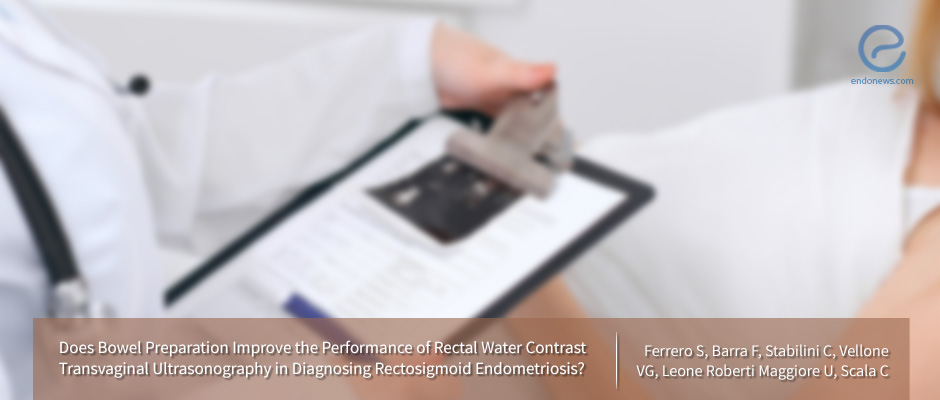Is bowel preparation really necessary before rectal water contrast-transvaginal ultrasonography?
Dec 13, 2018
Transvaginal ultrasonography is the first line investigation in patients with suspicion of DIE.
Key Points
Highlights:
- Rectal contrast bowel-transvaginal ultrasonography (RCW-TVS) technique is useful to distend the rectosigmoid colon by using a saline solution before performing transvaginal ultrasonography.
Importance:
- In all previous studies, specialists used a bowel preparation before performing diagnostic "rectal contrast bowel-transvaginal ultrasonography" for diagnosing their patients with deeply infiltrating endometriosis.
What's done here:
- Researchers planned to compare the performance of "rectal contrast bowel-transvaginal ultrasonography" with or without bowel preparation in same patients, in terms of detecting the length of the largest nodules, infiltration of the mucosa and the distance of nodules to the anal verge, as well as multifocality.
Key Results:
- There is no statistical significance between the findings "with" or "without" bowel preparation before "rectal contrast bowel-transvaginal ultrasonography" examination of patients either in diagnosing mucosal infiltration rates compared to histopathologic results; or in the accuracy of diagnosing multifocal bowel nodules.
- The intensity of pain reported by patients during their ultrasonography with or without BP was not statistically different.
- The presence of a bowel preparation does not improve the performance of "rectal contrast bowel-transvaginal ultrasonography" to diagnose and to assess the characteristics of nodules assessed in the same endometriosis patient.
Strength and Limitations:
- Strengths: Prospective design of the study and the quite large sample size, uniformity of bowel preparation technique, with independent and blinded gynecologists performed the rectal contrast bowel-transvaginal ultrasonography RWC‐with and without bowel preparation.
- Limitations:
- In the current study, the gynecologists performing rectal contrast bowel-transvaginal ultrasonography were extremely competent in the technique for diagnosis of DIE; accordingly, when performed by less experienced operators, results may not be similar.
- The study is aimed only to evaluate the rectosigmoid endometriosis, and other DIE lesions were not evaluated. Vaginal nodules, rectovaginal nodules, and nodules of the uterosacral ligaments, thus may have failure getting similar results for other pelvic locations.
Lay Summary
Ferrero et al., from Unit of Obstetrics-Gynecology in IRCCS Ospedale Policlinico San Martino, Genoa, Italy, recently published a prospective study in the Journal of Ultrasound Medicine.
The first aim of the authors was to compare the performance of "Rectal Water Contrast Transvaginal Ultrasonography" with or without bowel preparation (BP). The second objective was to compare the estimated length of major nodules, mucosal infiltration levels, the distance of nodules from the anal verge, and the presence of multifocal disease inventions of two diverse methods.
They also evaluated the intensity of pain reported from patients with or without BP, according to the 100 mm visual analog scan. Appropriate statistical analyses were used to compare the performance of the technique, with or without BP.
A hundred and fifty-five patients with suspicious of DIE, 92 of them having rectosigmoid endometriosis included in the study. Two highly specialized gynecologist performed their ultrasonographic examination who were only informed about the clinics of patients. The first gynecologist performed "rectal contrast bowel-transvaginal ultrasonography with BP", and one week to 2 months later other gynecologist examined the same patients "without BP".
Surgery of patients was performed within 6 months after the second examination, and the surgeons were blinded about the findings in both "rectal contrast bowel-transvaginal ultrasonography" examinations. The ultrasonographic, surgical and pathologic results of patients showed no statistical difference when the results for "rectal contrast bowel-transvaginal ultrasonography - with or without bowel preparation" were compared.
The authors concluded that although "rectal contrast bowel-transvaginal ultrasonography" is mainly aimed to evaluate endometriotic lesions in the rectosigmoid colon, other locations of endometriosis such as rectovaginal, vaginal and uterosacral nodules were out of the aim in their study.
This research might have the failure of investigation to assess the advantage of bowel preparation method to notice other endometriotic lesions in the pelvis.

